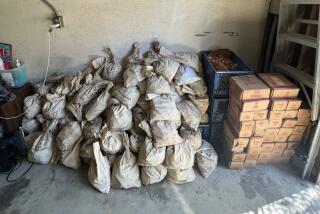It’s a Money-Making Factory : History, Industry on View at U.S. Mint
- Share via
PHILADELPHIA — No, they don’t hand out free samples at the U.S. Mint in Philadelphia. And no, you cannot buy a $1 bill hot off the press.
Dollar bills are not made in this government factory just a few blocks from Independence Hall.
They make coins here, about $1-million worth a day--buckets, tubs, vats full of shiny, alluring coins. So many that you might have an urge to plunge your hands into them all the way up to your elbows, just to enjoy the feeling of them.
You can’t do that, of course. Visitors are restricted to an observation level about three stories above the factory floor. They don’t get anywhere near the new coins.
Visitors aren’t allowed to walk through the mint’s production area for two reasons. One is security. Even the 550 employees have to go through two security checks before they leave the building every day. The other reason visitors are not allowed on the factory floor is that the mint, like many industrial operations, is noisy, dirty and potentially hazardous plant, complete with forklifts and cranes.
The massive, pink-granite U.S. Mint building at Fifth and Arch streets covers five acres, though visitors don’t see it all.
Although Benjamin Franklin was not involved in establishing the mint, people often toss pennies on his grave nearby.
The nation’s first mint, just two blocks from the present building, opened in 1792, when Philadelphia was the capital. The current mint, the fourth in the city, opened in 1969. It was specifically designed to accommodate visitors.
Touring the mint doesn’t cost a penny. Much of it is more like a museum than a factory. Exhibits about the mint’s history, products and technology fill the lobby, mezzanine and visitors’ gallery.
The exhibits include old production equipment and national, military and presidential medals, Indian peace medals, commemorative and uncirculated coins. All reflect American history and progress.
The tour is self-guided, with brochures to explain what you are seeing, and more can be learned by pushing buttons along the way.
Eleanor McKelvey, the mint’s exhibits and public services manager, said the Philadelphia mint makes about 30 million coins a day, three-fourths of them pennies. About half the coins used in the United States are made here; the rest are made in Denver.
High-quality proof coins, which are valued by collectors and do not go into circulation, are struck at the San Francisco mint, which also makes pennies when demand is high.
The mint is one of the few federal agencies that makes a profit.
“Not only do we literally make money,” said McKelvey, “but we really make money.”
A $518-million profit in 1986 was possible, McKelvey explained, because it costs the mint only 1 cent to make two pennies, less than 2 cents to make a dime, less than 3 cents to make a nickel or a quarter and less than 6 cents to make a half-dollar.
Each batch of freshly minted coins is inspected by a press operator with a magnifying glass. Bad coins are melted. Machines count the coins and drop them into canvas bags, which are sewn shut.
The sealed bags are stacked about 10 deep on pallets and stored in warehouse-size vaults. Trucks or armored cars are driven into the building to load the coins for shipment to Federal Reserve banks, which distribute them to local banks.
Although the mint’s primary job is to make coins, it also designs and manufactures medals. The floor where medals are made also can be seen from the observation level.
Visitors can see old coins, such as tiny gold dollars and Indian-head pennies, and bullion boxes used to carry gold bars. The gold coins in the Rittenhouse exhibit room are real, but the fat bars of gold and silver are not.
Artifacts from old mints include one of the first coin presses from the time when coins were made by hand, one at a time.
More to Read
Sign up for The Wild
We’ll help you find the best places to hike, bike and run, as well as the perfect silent spots for meditation and yoga.
You may occasionally receive promotional content from the Los Angeles Times.






